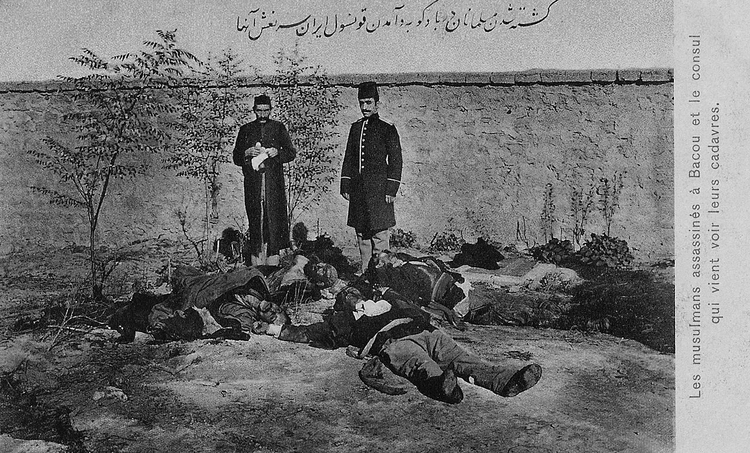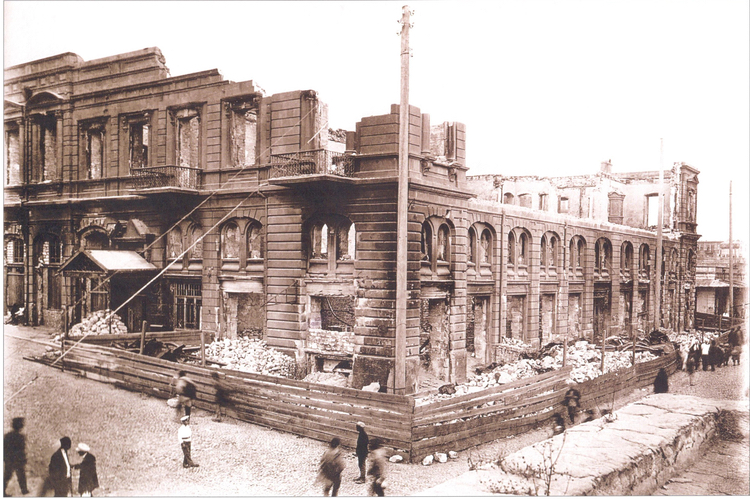The genocide of 1918
At the different stages of history, Armenian nationalists, in order to implement the mythical ideas of the “Great Armenia”, implemented ethnic cleansing, deportations and genocides against our fellow citizens. One of the most bloodcurdling tragedies against the Azerbaijani people, is the massacre which committed with particular brutality 100 years ago - in March-April 1918, the Dashnak-Bolshevik armed groups operating under the mandate of the Baku Soviet.

Under the government of the Bolshevik-Dashnak regime, headed by the chairman of the Baku Council of People's Commissars S.Shaumyan, the growing process of national revival and the growing authority of the Musavat party brought the Bolshevik-Dashnak groups closer together.
There was neither authority nor a social base of Bolsheviks among the local population. The results of the elections to the Baku Council held in October 1917 clearly provide testimony of this fact. In the elections, the Bolsheviks, having collected an insignificant number of votes, seriously lost the “Musavat” party. The Bolsheviks were seriously troubled by the stubborn struggle of the Musavat party for the territorial autonomy and political power of Azerbaijan. Which is why Shaumian, to implement a national massacre in Azerbaijan against Azerbaijanis, wanted to strangle the national liberation movement of the people awakening in the cradle, weaken the social base of the Musavat party and “teach the lesson” to Muslims.

standing next to the corpses
Shaumyan was seriously preparing to commit the genocide against the Turkish-Muslim population of Baku. He was writing a letter to Stalin, asked him to urgently send a million rubles for the formation of the Caucasian Red Army. Although, as a result of the obstacles created by the Terek-Dagestan Muslim government, which it is been created at that time in the North Caucasus, the echelons with the products sent by the Bolsheviks to Shaumyan, did not reach Baku. But anyway Armenians received the great moral support from Moscow. In December 29, 1917, Lenin signed a document, that granting autonomy to Armenians in Turkey. This document further strengthened the Dashnak-Bolshevik alliance. "Dashnaktsutyun" has been like the shock force of the Bolsheviks during the Events, which committed in March 1918 in Baku. On the other hand, S. Shaumyan organized the concentration of Armenian soldiers and officers in Baku, who were returning from the fronts of the First World War. Then, on April 19, 1918, at a meeting of the Baku Council, Shaumyan admitted he was very frightened by the ethnic composition of Baku, and he could not refuse from help of the Armenian-Dashnak regiments.
Undoubtedly, the main organizer and executor of the March genocide perpetrated against Azerbaijanis in Baku, was Shaumyan, the temporary emergency commissioner for Caucasus affairs, who appointed by V. Lenin. The “Red Army”, which formed by him, might be said to be completely composed of Armenians.

For the implementation of this crime was necessary pretext. For this purpose, provocation was carried out on “Evelina” steamer. The son of an Azerbaijani millionaire Haji Zeynalabdin Taghiyev, Mamed Taghiyev, who served in Lenkoran, died as a result of careless handling of firearms, and the officers of the Muslim regiment arrived in Baku to participate in his funeral. After the funeral, the officers should have been return to Lankaran on "Evelina" streamer. The Armenians, have been seeing that the time was ripe, break the rumor among the Russian National Council, the Caspian sailors, the Socialist-Revolutionary and Menshevik parties, that these officers, supposedly, received a task together with the Muslim detachments in Lankaran, to destroy the Russian-Molokan villages of Mugani. This provocation worked: all non-Azerbaijani parties and armed groups in Baku advocated the disarmament of the “Evelina” ship.
On March 30, the Revolutionary Defense Committee of the city of Baku and its industrial and factory districts were formed as a matter of urgency. At the initiative of the committee, the departure of “Evelina” steamer was delayed, and the officers on the steamer were disarmed. Then the Muslim population, gathering in mosques, demanded the return to the officers of their weapons.
Seeing the serious turn the situation took, representatives of the national organizations of Azerbaijan came to the Revolutionary Committee and tried to return the selected weapons with the help of the Muslim Bolshevik Committee “Gummet”. On March 30, at a meeting with S. Shaumyan in the house of N. Narimanov and at a meeting held by M.E. Rasulzade in the Revolutionary Committee, an agreement was reached on returning weapons, but the Dashnak-Bolshevik coalition did not keep its promise.
On March 30, at about 4:40 pm, Dashnak groups gathered near the Armenian Church , opened the first volleys and began the massacre. Early in the morning of March 31, Bolshevik-Dashnak detachments attacked “Karpichkhana”, “Mammadli” and other Azerbaijani blocks. At the request of Shaumyan and the special order of Lenin, 2 airplanes which sent from Tsaritsyno began to bomb Azerbaijani quarters from the air, and warships from the sea.
Dashnaks, taking advantage of the right moment to persecute the Azerbaijani people, setting up tools on the barges of the Armenian oil owners, shot the villages of the north of Absheron.
Towards the morning of March 31, all the leaders of the Armenian armed groups and the armed Armenian intelligence arrived at the Headquarter of the Revolutionary Defense Committee, where they received brief instructions and were sent to Muslim quarters. The well-trained and heavily armed Armenian soldiers, bursting into the houses of Muslims, killed the residents of these houses, and chopped them up with swords and daggers and stabbed them with bayonets, threw the children into the fire of the burning house and raised the infants to bayonets. In order to intimidate the civilian population and achieve their goals, the Bolshevik-Dashnak executioners, resorting to all kinds of atrocities, killed Muslim women in a more serious form. Only in one place in the city, were found 57 corpses of women with their ears, noses and ripped stomachs cut off. Many young women were nailed to the wall alive. Those who tried to flee were shot with machine guns, which installed in the various places in the city.
By the evening of March 31, while the Muslim quarters had already been defeated, began the assault of Icherisheher. The report of the chairman of the emergency committee of the Ministry of Justice noted: The advancing Armenian soldiers along Nikolayevskaya Street were led mainly by representatives of the Armenian intelligence. One of these detachments climbed into the house and shot 8 women and children. Another detachment, climbed into the house of Bala Ahmed Mukhtarov, along Persian Street, out onto the street nine intelligent Muslims and shot them on the Cathedral Square, while two bodies were thrown into the fire of the burning Dagestan Hotel ..

On March 31, Azerbaijanis subjected to genocide ceased resistance. However, the Armenian Dashnak formations continued the genocide until late at night on April 2. Based on the official information, consequently of the March Events in Baku, more than 12,000 people were killed. Bolshevik-Dashnak formations burned the printing house “Kaspiy”, the editorial office of newspaper “Achyg Soz”, the “Ismailia” building (currently the building of the Presidium of the National Academy of Sciences of Azerbaijan) and damaged the minarets of “Tezapir” mosque with artillery fire.
After Baku, The Dashnak-Bolshevik military formations committed genocide against the Azerbaijani people in the regions of Karabakh, as well as in Eastern Anatolia and South Azerbaijan.
If, before the genocide of March 1918, the national-democratic forces of Azerbaijan came out with a demand for national-territorial autonomy within Russia, then after the massacres, hopes for that were lost. In consequence of the March genocide, was dealt a crushing blow to the idea of Sovietization, that was alien to the Azerbaijani people, and the people's determination to restore independent statehood became even stronger.
According to the Decree of the President of the Republic of Azerbaijan “On the Genocide of Azerbaijanis” dated on March 26, 1998, March 31 was declared as the Day of the Genocide of Azerbaijanis.
In order to more fully communicate to the republican and world community the truth about universal crimes committed by the Armenian-Bolshevik armed groups against Azerbaijanis 100 years ago, the President of the Republic of Azerbaijan on January 18, 2018 signed the decree “On the 100th anniversary of the genocide of Azerbaijanis of 1918”.
Reference used:
Encyclopedia of Azerbaijan Democratic Republic. The second volume, Baku: Lider press, 2005, p. 174-177.
